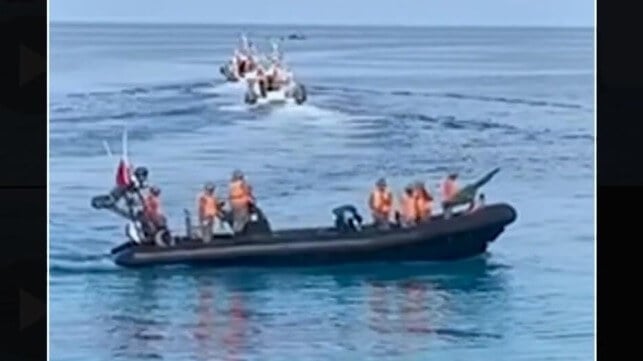China Coast Guard Up-Guns its Presence at Scarborough Shoal

The China Coast Guard has up-gunned its patrol forces at Scarborough Shoal after a series of high-profile security developments at the reef, including an embarrassing collision between a Chinese PLA Navy warship and a China Coast Guard cutter earlier this month.
The Armed Forces of the Philippines (AFP) regularly monitors Chinese movements at Scarborough Shoal, which China seized from the Philippines in 2012. Philippine fishermen maintain a presence at the reef, supported by regular government resupply missions, and the China Coast Guard routinely attempts to curtail or harass their operations.
According to the AFP, China Coast Guard small boats at Scarborough have now been fitted with crew-served weapons, a development not previously seen in the area. The up-gunned small craft are a concerning development for the AFP: China Coast Guard boarding teams used similarly-equipped fast boats during the armed attack at Second Thomas Shoal last year, a violent altercation which resulted in one Philippine marine losing a finger.
The AFP patrol spotted five China Coast Guard vessels at Scarborough, along with 11 fast boats and two Chinese aircraft. Some of the CCG cutters were observed practicing the use of their water cannons, which have been used in the past to intimidate or damage Philippine vessels.
AFP Monitoring Reveals Increased Chinese Movements in Ayungin Shoal
— Armed Forces of the Philippines (@TeamAFP) August 21, 2025
Through its Maritime Domain Awareness (MDA) monitoring, the Armed Forces of the Philippines (AFP) has observed an increase in the presence of Chinese vessels in the vicinity of Ayungin Shoal on August 20.
China… pic.twitter.com/Ad55gg7DDT
Scarborough Shoal has been a flash point in the territorial conflict between China and the Philippines for more than a decade, but the intensity of the confrontation has been heating up. On August 11, while chasing a pair of Philippine Coast Guard cutters around Scarborough, a Chinese PLA Navy warship cut across the bow of a China Coast Guard cutter at high speed, initiating a collision that damaged the Chinese cutter and generated embarrassing press coverage. Two days later, the Arleigh Burke-class destroyer USS Higgins sailed past Scarborough on August 13, challenging China's claims of control and drawing stern protests that the passage had “seriously violated China’s sovereignty and security."
China claims most of the Philippines' western exclusive economic zone as Chinese sovereign territory, even though it is located hundreds of miles from the Chinese mainland. Beijing bases its claim on a historical map feature from the 1940s, the "nine-dash line," which purports to show Chinese control over the majority of the South China Sea. The Permanent Court of Arbitration in the Hague invalidated these historical claims in 2016, but China has ignored the ruling.
